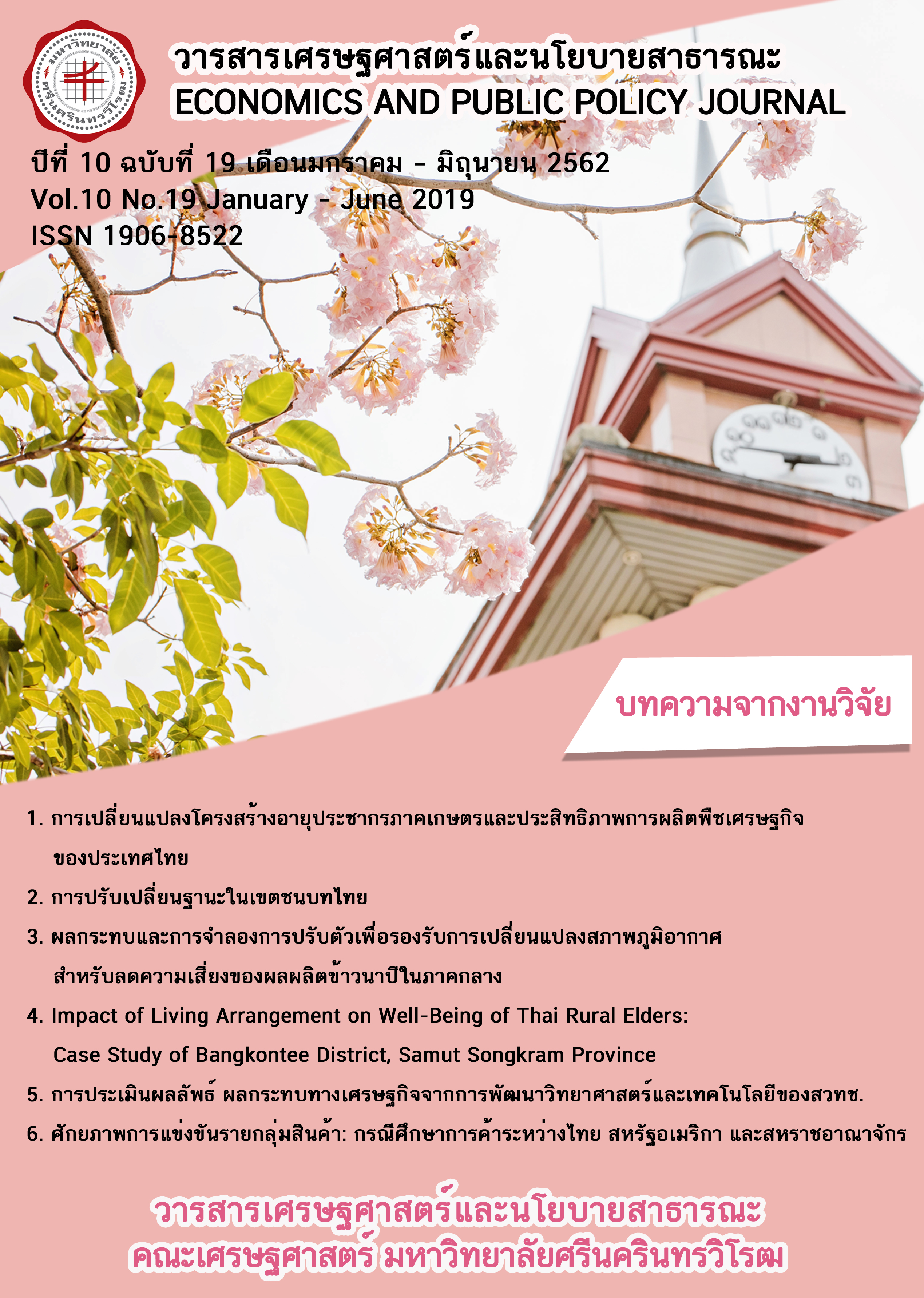การปรับเปลี่ยนฐานะในเขตชนบทไทย: กรณีศึกษาใน 4 จังหวัด
Main Article Content
บทคัดย่อ
งานวิจัยนี้ศึกษาปัจจัยที่ส่งผลต่อการปรับเปลี่ยนฐานะของครัวเรือนในเขตชนบท โดยใช้รายได้ครัวเรือนที่ปรับด้วยค่าปรับขนาด (OECD equivalence scale) เป็นตัวชี้วัดฐานะของครัวเรือน ข้อมูลที่นำมาศึกษาเป็นข้อมูลการเก็บตัวอย่างซ้ำในปี 2543 และ 2556 จากการสำรวจโดยสถาบันวิจัยเพื่อการประเมินและออกแบบนโยบาย (Research Institute for Policy Evaluation and Design: RIPED) ในเขต 4 จังหวัด ได้แก่ ฉะเชิงเทรา ลพบุรี บุรีรัมย์ และศรีสะเกษ และใช้แบบจำลองการถดถอยแบบพหุเชิงซ้อนในการวิเคราะห์ จากการศึกษาพบว่าครัวเรือนในเขตชนบทนั้นมีการปรับเปลี่ยนฐานะทางรายได้ที่ค่อนข้างดี (มีลักษณะลู่เข้าหาค่าเฉลี่ยของรายได้) ปัจจัยสำคัญที่จะช่วยสนับสนุนการปรับเปลี่ยนฐานะของครัวเรือน ได้แก่ ระดับการศึกษาที่สูงขึ้น การลดลงของสัดส่วนเด็กและสัดส่วนผู้สูงอายุ การมีงานทำ ที่รวมถึงการมีที่ดินที่ใช้ในการเกษตรเพิ่มขึ้น
Article Details
สงวนลิขสิทธิ์ © 2553 คณะเศรษฐศาสตร์ มหาวิทยาลัยศรีนครินทรวิโรฒ
คณะเศรษฐศาสตร์ มหาวิทยาลัยศรีนครินทรวิโรฒ จัดพิมพ์วารสารเศรษฐศาสตร์และนโยบายสาธารณะ เพื่อเผยแพร่บทความวิชาการทางเศรษฐศาสตร์ นโยบายสารธารณะ และสาขาอื่นๆที่เกี่ยวข้อง ทัศนะและข้อคิดเห็นใดๆ ที่ปรากฏในวารสารเป็นความคิดเห็นส่วนตัวของผู้เขียน โดยบทความที่ได้รับการตอบรับจะถือเป็นลิขสิทธิ์ของคณะเศรษฐศาสตร์ มหาวิทยาลัยศรีนครินทรวิโรฒ
บรรณาธิการ อาจารย์ ดร.พลพัธน์ โคตรจรัส
เอกสารอ้างอิง
ปีที่ 34 ฉบับที่ 3 ธันวาคม 2559, 60-95.
สถาบันวิจัยเพื่อการประเมินและออกแบบนโยบาย (2556). ฐานข้อมูลระดับครัวเรือนแบบตัวอย่างซ้ำเพื่อการวิจัยด้านเศรษฐศาสตร์และสังคม, มหาวิทยาลัยหอการค้า.
Banerjee, A. N., Banik, N., & Mukhopadhyay, J. P. (2015). The Dynamics of Income Growth and Poverty: Evidence from Districts in India. Development Policy Review, 33(3), 293–312.
Bukstein, D., & Gandelman, N. (2014). Intra-Generational Social Mobility and Entrepreneurship in Uruguay. Latin American Journal of Economics, 51(2), 227–245.
Castellani, F., & Lora, E. (2014). Is Entrepreneurship a Channel of Social Mobility in Latin America? Latin American Journal of Economics, 51(2), 179–194.
Chawanote, C., Barrett, C. B., & Dyson, C. H. (2014). Farm and Non-farm Occupational and Earnings Dynamics in Rural Thailand. Cornell University. Retrieved from http://barrett.dyson.cornell.edu/files/papers/FarmNFDynamics_ChawanoteBarrettFeb2014.pdf
Cuesta, J., Pizzolitto, G., & Ñopo, H. (2011). Using Pseudo-Panels to Measure Income Mobility in Latin America. IZA Discussion Paper, (5449), 224–246.
Deaton, A. (1986). Consumer’s Expenditure. Palgrave New Dictionary of Economics.
Dercon, S., & Krishnan, P. (2000). Vulnerability, Seasonality, and Poverty in Ethiopia’, Journal of Development Studies. Journal of Development Studies, 36, 25–53.
Fields, G. S. (2001). Distribution and Development: A New Look at the Developing World.
Fields, G. S., Cichello, P., Freije, S., Menendez, M., & Newhouse, D. (2003). For Richer or for Poorer? Evidence from Indonesia, South Africa, Spain and Venezuela. Journal of Economic Inequality 1(1), 67–99.
Fields, G. S., Duval--Hernández, R., Freije, S., & Sànchez Puerta, M. L. (2007). Earnings Mobility
in Argentina, Mexico and Venezuela: Testing the Divergence of Earnings and the Symmetry
of Mobility Hypotheses. IZA Discussion Paper.
Forbes, K. (2000). A Reassessment of the Relationship between Inequality and Growth. Merican Economic Review, (90), 869–87.
Grootaert, C., & Kanbur, R. & O. G.-T. (1995). The Dynamics of Poverty: Why Some People Escape from Poverty and Others Don’t. An African Case Study.
McCulloch, N., & Calandrino, M. (2002). Poverty Dynamics in Rural Sichuan between 1991 and 1995.
Nee, V. (1994). The Emergence of a Market Society: Changing Mechanisms of Stratification in China.
Sakondhavat, A. (2013). Understanding Poverty Dynamics Using a Mixed-Method Study: Evidence from the rural village in the Northeast and Central Regions of Thailand. University of Sussex.
Woolard, I., & Klasen, S. (2005). Determinants of Income Mobility and Household Poverty Dynamics in South Africa. Journal of Development Studies, 41(5), 865–897.
Wooldridge, J.M. (2013) Introductory Econometrics: A Modern Approach. 5rd Edition, Thomson/South-Western, Mason.


